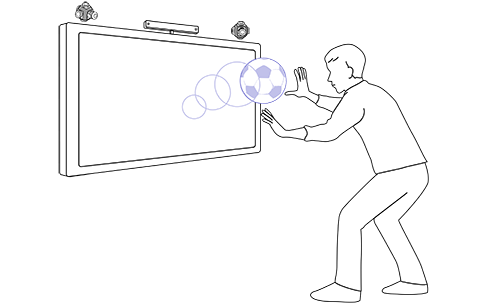Puffs of compressed air create sensations that can be associated by the user with textured surfaces or force feedback.
Disney Research’s own site has some great multimedia on the topic, but according the following announcement gives you the gist of it:
Depth cameras and other motion-tracking devices allow people to use natural gestures to play computer games, yet the experience remains unnatural because they can’t feel what their eyes can see. Disney Research, Pittsburgh, has developed a solution, however, that could enhance not only games, but a variety of virtual experiences.

Called AIREAL, the new technology uses controlled puffs of compressed air – something akin to smoke rings – to create the impression of a ball bouncing off a hand, of an arm tingling from the flutter of a butterfly’s wings, or of the rippling of air as a seagull circles a user’s head.
Unlike jets of air, which are hard to maintain and control over long distances, these rings of air, called vortices, can travel relatively long distances without dissipating and can be targeted with accuracy. By varying the intensity, frequency and targeting of the pulses, the researchers are able to create a number of tactile effects, including objects with textured surfaces and force feedback for gestures.
“What makes this particularly exciting is that we can create these effects literally out of free air, without the need for people to wear special gloves or vests, hold haptic devices or sit in instrumented chairs,” said Ivan Poupyrev, senior research scientist at Disney Research, Pittsburgh. “The technology for creating these effects is scalable and relatively inexpensive, so we can envision using AIREAL to create magical experiences both for large groups of people and for an individual in her living room.”
Poupyrev and his Disney Research, Pittsburgh colleagues, Rajinder Sodhi, Matthew Glisson and Ali Israr, will present their research findings and demonstrate the AIREAL technology at ACM SIGGRAPH 2013, the International Conference on Computer Graphics and Interactive Techniques, July 21-25 in Anaheim, Calif.
Sodhi, a Ph.D. student in computer science at the University of Illinois, Urbana-Champaign and the lead researcher for the AIREAL project, said creating haptic displays in free air has been a long- standing challenge, but one that has gained urgency with the advent of Microsoft’s Kinect depth camera and Nintendo’s Wii controller and the gesture-controlled games they enable.
“One of the big challenges in these games is that you get visual feedback, but you can’t feel anything,” Sodhi said. A player may think he has successfully smacked a virtual ball that he sees flying toward him, but can’t know for sure if he hit it until he sees the ball bounce away.
Creating the sort of high-resolution effects these games demand is difficult with air jets, which are either too weak to project over long distances or so powerful that it hurts the resolution of the tactile feedback. Sodhi said ultrasound-based acoustic radiation fields have been used to create high-resolution effects, but have limited range.
The physics of the swirling ring of air known as a vortex enables the vortex to maintain its shape and energy over relatively long distances and makes it possible to target the vortex accurately. The Disney Research, Pittsburgh researchers produced air vortex generators by using five 2-inch speakers as actuators to create a pulse of air that is directed through a 3D-printed flexible nozzle. The pulse of air forms into a ring as it exits the nozzle. Actuators move the nozzle as necessary to direct the vortices at the user.
The researchers found that the vortices could be controlled effectively to a distance of 1½ meters, and could still be felt at more than twice that distance. The vortex generators are inexpensive, they noted, so several might be used to create effects. One challenge with vortices is they travel along a straight path. The researchers are working on a number of methods for controlling when and where a vortex stops moving.
The device can also be scaled to any size. “You can make the technology small enough to attach to a mobile device, or you can make it big enough to emit sensations that travel across multiple rooms,” Sodhi said.
Though computer games may have driven the development of free air haptics, they have many potential applications, notably for virtual environments. By combining AIREAL with projection technology, for instance, the researchers were able to design an experience in which a butterfly is projected on a person’s arm and the person can feel the butterfly flap its wings.
Another possible application is “ambient haptics,” where other things in the environment visibly react to a virtual object. If the image of a ball of “fairy dust” is projected so that it appears to explode near a houseplant, AIREAL can make the plant’s leaves move to react to the blast, Sodhi said.
“One of our long-term visions is to create complete 3D shapes in the air,” Sodhi said. “Imagine holding out your hand and feeling someone’s face. This will start truly eroding the boundary between real and virtual”.






